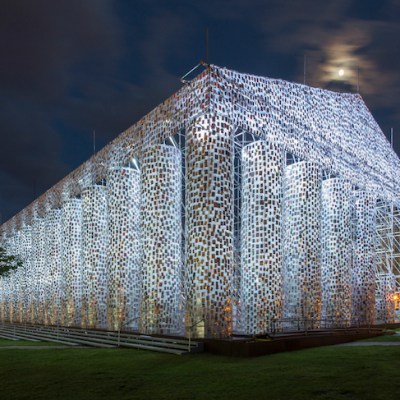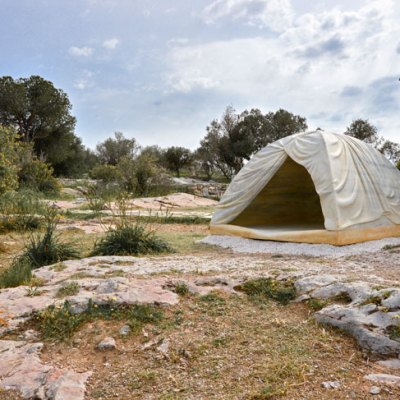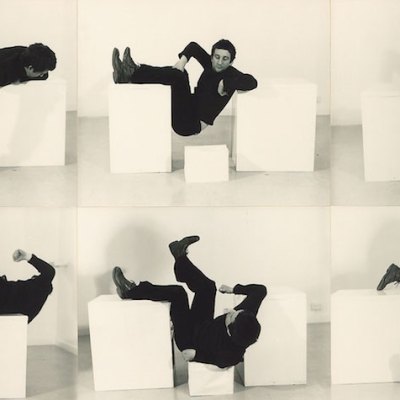Inside the rooms of the National Observatory of Athens – Greece’s oldest research institution, founded in 1842 – heavy blackout curtains are left partially open to reveal chinks of light that give way to distant views of the Acropolis. I’m not surprised that Adrián Villar Rojas, whose work often has ruin at its heart, has focused on this historical monument for his exhibition ‘The Theater of Disappearance’ (an umbrella title that the artist has given to four international exhibitions this year). At the very least, it’s a teasing nod to the inescapability of the Parthenon, which looms large over the city. Interested in the ways we preserve and interpret the past, Villar Rojas is perhaps less concerned with remains than with absences: how history is partial and constituted out of fragments. It is striking that such investigations into what is made visible and invisible take place in a building committed to the act of looking.
‘The Theater of Disappearance’, Adrián Villar Rojas, National Observatory of Athens, Hill of the Nymphs. Photo: © Panos Kokkinias, courtesy NEON

Villar Rojas’s intervention – presented by the Athens-based non-profit organisation Neon, whose gallery space is the city itself – also disrupts the grounds of the observatory, which sits atop the Hill of the Nymphs. At first, it’s hard to see exactly what the artist has done; it’s only when Neon director Elina Kountouri walks me around that the scale of Villar Rojas’s disruption becomes clear. Surrounding the observatory are narrow pathways, dense with lush vegetation. Bright orange pumpkins are dotted around and, perhaps most distinctively, tall rows of corn sprout from the ground. To the left of the observatory’s entrance is a mound of the chipped, curving, intertwined root crowns of fallen trees; elsewhere grey stone cylinders sit engulfed in a patch of vivid green grass. A 3D-printed model of the Hill of the Nymphs that Villar Rojas has placed in the doorway of the observatory reminds us what the site looked like 160 years ago. Today, as Kountouri explains, it is normally an open, flat, and much less green space.
‘The Theater of Disappearance’, Adrián Villar Rojas, National Observatory of Athens, Hill of the Nymphs. Photo: © Panos Kokkinias; courtesy NEON

Prevented from digging down into the ground due to the archaeological importance of the site, Villar Rojas has instead planted above it. Over months of construction, protective structures were built over the existing soil and an independent irrigation system was installed. A remarkable 46,000 plants from 26 plant species – including wild grasses, grains, fruit and vegetables – are growing side by side, dramatically altering our experience of the space. From out here, in this circumscribed land, the city itself disappears, the Acropolis all but invisible.
A meditation on integration and growth, the project is also an enquiry into soil, land, and identity. Following extensive research, including visits to archaeological sites in the Peloponnese, Villar Rojas reflected on how, for the Greeks, the ground below is representative of their cultural identity and is fiercely protected (the decision in 1842 to build the observatory – itself emblematic of modern scientific progress – on a site of antiquity was deeply controversial). In the artist’s native Argentina, soil is the main source of economic development, a means of production that is nevertheless a potent – albeit very different – symbol of nationhood. I’m reminded of the artist’s exhibition at the Serpentine Gallery in 2013, in which he made an ancient world out of clay – a material that he frequently uses. As in that exhibition, the world Villar Rojas has created here is a fabrication, one reminding us that national identity, too, is a construction.
Above the observatory’s entrance is written ‘Servare Intaminatum’ (to be kept intact), a dictum that Villar Rojas has temporarily flouted. The artist is well known for site-specific projects that change and challenge the spaces in which he works. For My Dead Family (2009) he created a life-size clay whale that lay in a forest in Patagonia and, in a poignant meditation on migration made for the Istanbul Biennial in 2015, he placed 17 fibreglass sculptures of animals at the edge of the sea of Marmara on the island of Büyükada. Research for this Athens project took Villar Rojas to Lesvos, a focal point of the refugee crisis in Greece, and the work engages starkly with ideas about borders, co-existence, protectionism and trade (the artist’s use of the corn crop is no accident, embedded as it is in a global capitalist commodity culture). He has also contemplated Argentina’s centuries-old experience of immigration, as well as the fraught period in which the National Observatory was founded, when a newly independent Greece was focused on nation building, territorial advancement and positioning itself at the centre of Europe.
‘The Theater of Disappearance’, Adrián Villar Rojas, National Observatory of Athens, Hill of the Nymphs. Photo: © Panos Kokkinias; courtesy NEON

On the barren slopes of what is usually a deserted area, Villar Rojas has placed (and in some cases, hidden) 11 glass vitrines. In these, he has positioned relics from the past alongside artefacts that evoke the future: a replica of the 3.2 million-year-old fossilised bones of the australopithecine ‘Lucy’ – a find that challenged prior understanding of human evolution – sits alongside a space suit of the kind worn by Armstrong and Aldrin when they planted the American flag on the moon.
‘The Theater of Disappearance’, Adrián Villar Rojas, National Observatory of Athens, Hill of the Nymphs. Photo: © Panos Kokkinias; courtesy NEON

In another vitrine, sat on a bed of red dust, is a NASA Curiosity rover – the type of vehicle used to search for life on Mars in 2012. There is something cartoonish and outdated about this six-wheeled piece of technological wizardry. Elsewhere, a faded, damaged Argentinian flag rests on a Brown Bess musket; military boots from the Falklands War similarly seem to query man’s imperial aims. A toppled Winged Victory of Samothrace, no longer upright and victorious, is covered in graffiti – a cloak made from posters and leaflets found in Athens. What defines Greece’s identity now?
Adrián Villar Rojas, ‘The Theater of Disappearance’, National Observatory of Athens, Hill of the Nymphs. Photo: © Panos Kokkinias; courtesy NEON

One of the successes of Villar Rojas’s intervention – beyond its sheer scale – is the way its various meanings spill into each other or slip out of reach entirely. In its confusions of time and space, the conceptual implications of the project feel inexhaustible. I get lost on my second visit to the Observatory and ask directions from a Greek couple out on their regular evening stroll along the Grand Promenade circling the Acropolis. They ask me what I think of Athens and then, gesturing to that ancient monument – now in full view – tell me that Athenians are tied to their past, that they see where they’ve come from every day. It’s an almost irresistible encounter in the context of ‘The Theater of Disappearance’, which not only encourages its visitors to get lost but to look from a new perspective, to dig deeper, to see instead an invisible history.
‘The Theater of Disappearance’ is at the National Observatory, Athens, until 24 September.



